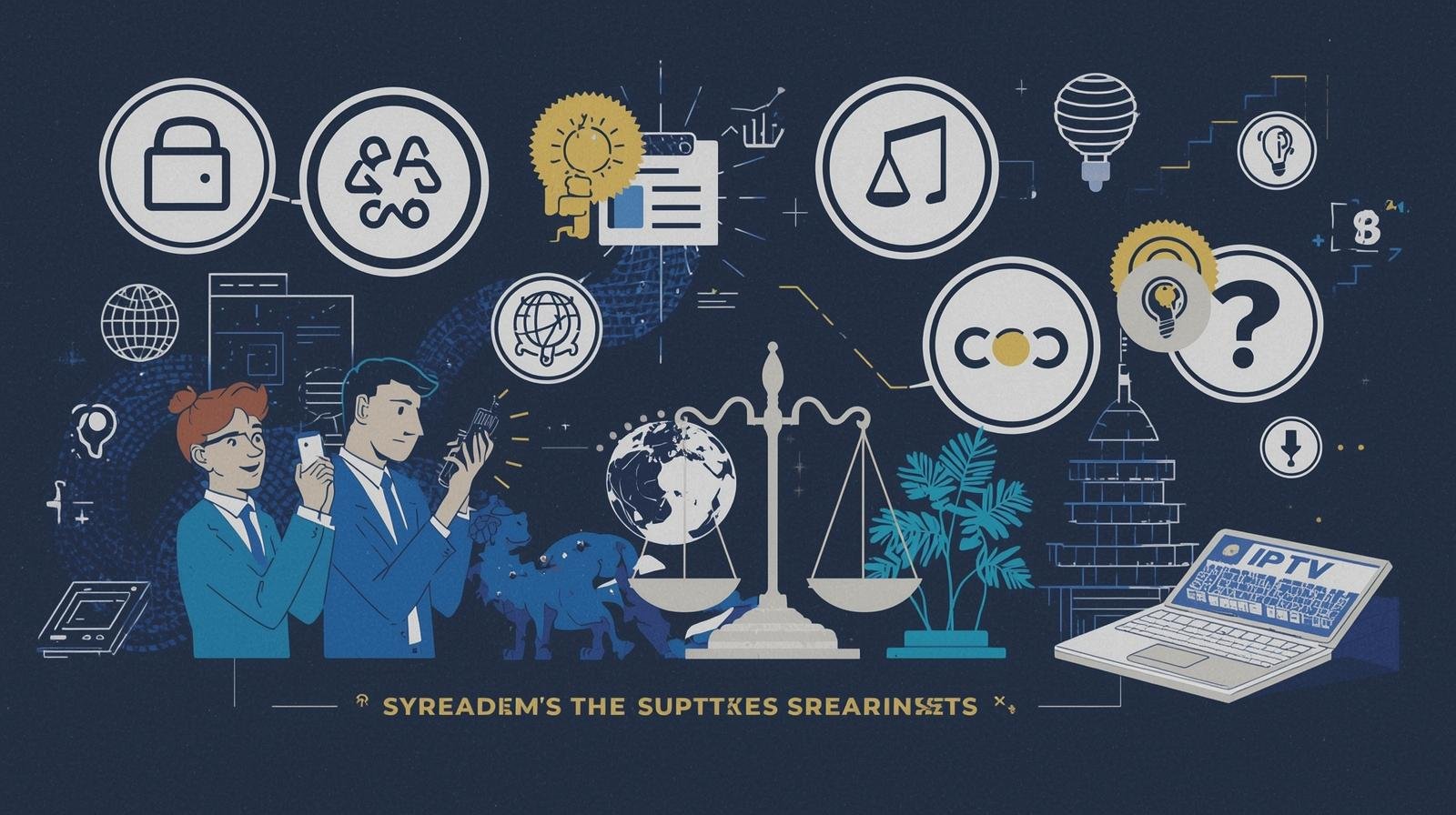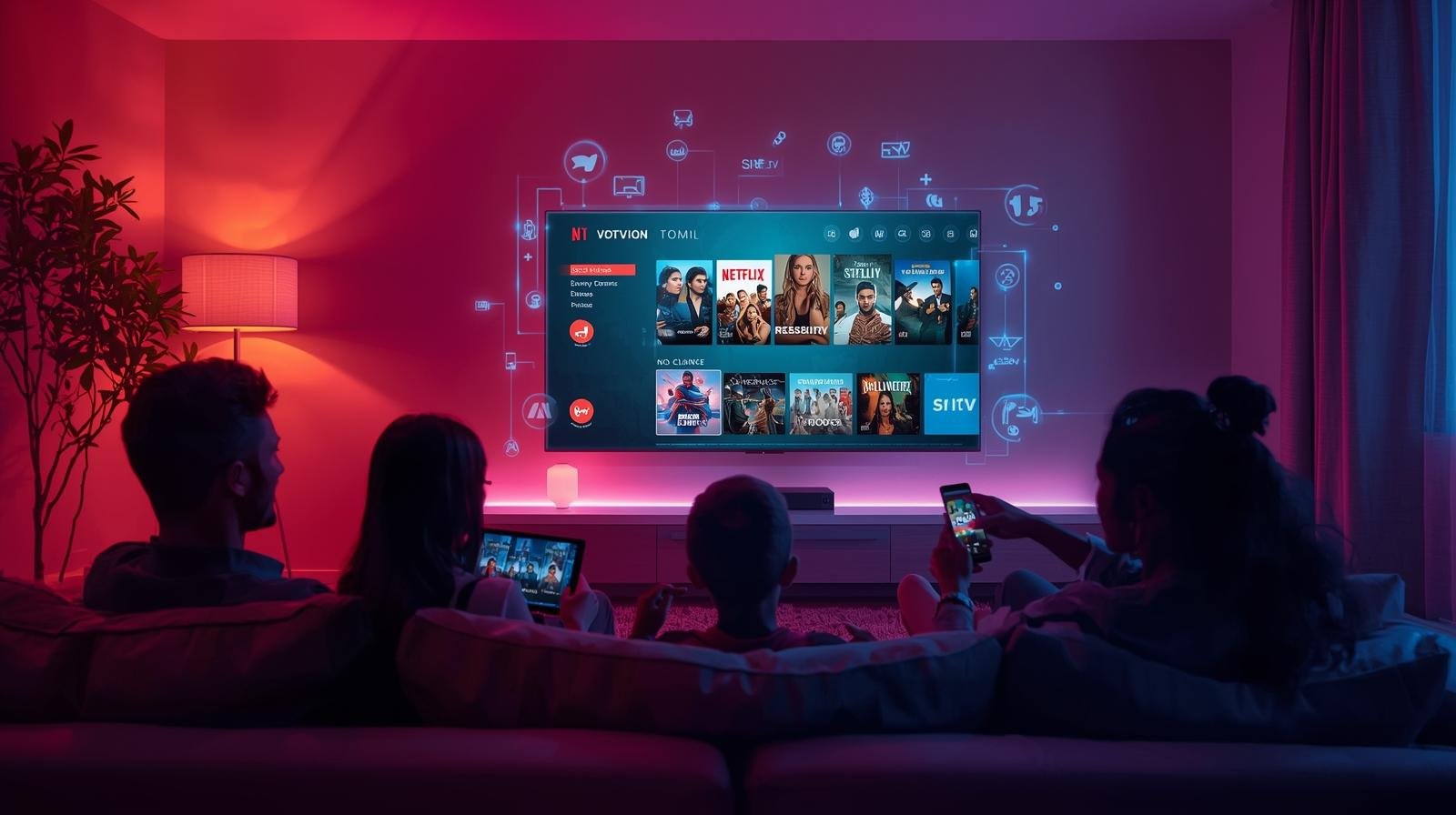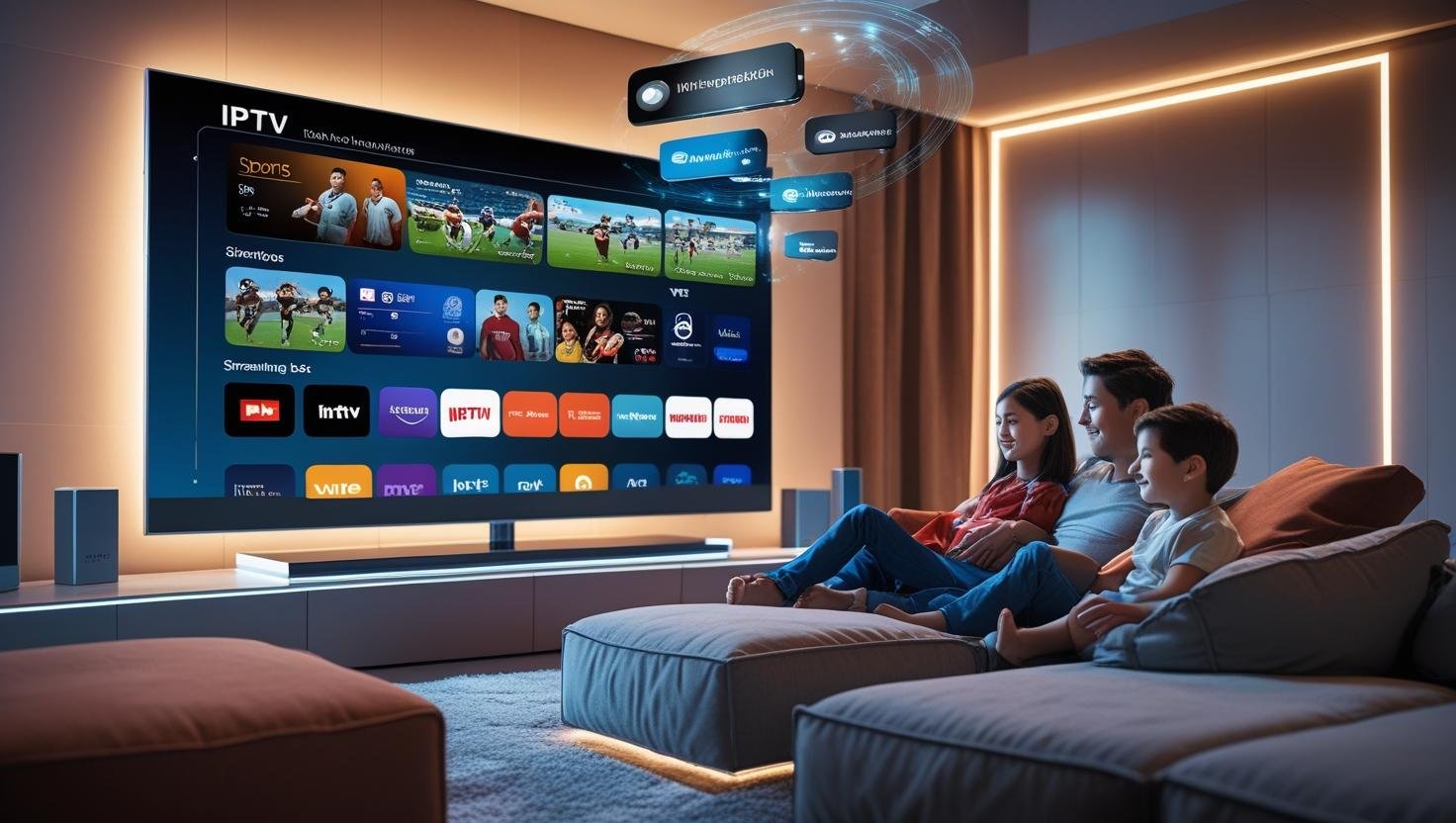1 — What is IPTV?
IPTV stands for Internet Protocol Television. It describes any system that delivers television content (live channels, on-demand programmes, or recorded video) over an internet protocol (IP) network instead of via terrestrial (Freeview), satellite (Sky) or linear cable (Virgin) broadcasts. Is IPTV Legal in UK?
Important distinctions:
- Technology vs legality: IPTV is a delivery method (like IPTV apps, smart-TV apps, or streaming boxes/sticks). The legality depends on whether the service has the rights to distribute the content. Using the delivery method is not illegal — streaming licensed BBC, Netflix, Disney+ or other official apps over IP is perfectly lawful.
- Legal IPTV examples: Official broadcaster apps (BBC iPlayer, ITVX, Channel 4’s All 4), large licensed streaming services (Netflix, Amazon Prime Video, Disney+), and ISP/broadcaster streaming bundles (Sky Stream, NOW, discovery+ packages) are legitimate IPTV offerings.
- Illicit IPTV examples: “Fully loaded” boxes, apps, or subscription services that promise access to hundreds or thousands of premium channels (Sky Sports, BT Sport/TNT Sports, movie channels) for a tiny monthly fee — without clear licensing — are almost always illegal.
2 — The legal framework (high-level)
For IPTV companies and customers in the UK, three legal pillars are essential:
2.1 Copyright legislation, particularly the 1988 Copyright, Designs, and Patents Act
The CDPA 1988 and subsequent amendments create criminal and civil offences for distributing copyrighted content without permission. Supplying or facilitating access to broadcasts or recorded content without rights can amount to copyright infringement and — where done knowingly or commercially — criminal conduct. Provisions pertaining to services or equipment intended to go around technological security measures are also included in the legislation.
2.2 Fraud, money laundering and related criminal laws
Where operators monetise illegal IPTV (subscriptions, advertising, funnels to other criminality), prosecutors often add charges under the Fraud Act and money laundering offences. The government and law enforcement have used a combination of copyright and financial crime laws to dismantle networks.
2.3 TV Licence law and live broadcasts
A TV license is required in the UK in order to use BBC iPlayer or to view or record live TV on any channel or device. That requirement applies regardless of whether the content arrives by aerial, satellite, cable, or IP-based streaming. A licence is separate from copyright enforcement — it’s an administrative requirement enforced by TV Licensing, and evasion can lead to fines up to £1,000.
3 — Why many people are uncertain: grey markets and “IPTV” marketing
Due to IPTV’s widespread use and the simplicity of setting up streaming stacks, two related issues arose:
- Third-party sellers packaging pirated streams into easy-to-use playlists, pre-configured “boxes”, or subscription portals; and
- Confusion among consumers who don’t distinguish between branded, licensed streaming services and cheap “all channels” subscriptions found on social media marketplaces.
Because the technology is neutral and many legal streaming services use the same protocols, a casual buyer may not realise a seller is offering unlicensed access until enforcement actions or shutdowns occur. Is IPTV Legal in UK?
4 — Recent enforcement in the UK (what’s changed in 2024–2025)
In the last 18–24 months the UK has seen a significant escalation in enforcement actions against illegal IPTV operators. Law enforcement and industry groups have focused on disrupting the supply side (servers, websites, data centres and sellers) rather than minor end-users. Is IPTV Legal in UK? Notable examples:
- High-profile sentencing (2025): The Police Intellectual Property Crime Unit (PIPCU) and associated agencies have prosecuted several operators, resulting in their imprisonment. For example, a man who ran a subscription IPTV service (aFINITY IPTV) was sentenced to five years for making around £300,000, and other operators were jailed after running large-scale services that sold access to thousands of channels. These cases underline that commercial operations running illegal streaming services can face substantial custodial sentences.
- Seizures and arrests: In mid-2025, PIPCU executed warrants, seized servers from UK data centres and arrested suspects believed to be operating illegal services. These investigations sometimes involve international cooperation and lead to the closure of servers and web portals used to distribute pirated streams.
- Organised crime links and money seizure: Sentences in 2025 included confiscation of proceeds and money-laundering charges — illustrating that illegal streaming is often treated as a profit-making enterprise akin to other organised intellectual property crime.
What these trends mean: law enforcement is prioritising supply-side disruption — seizing infrastructure and pursuing operators — and courts have demonstrated willingness to impose custodial sentences in serious commercial cases. That increases the legal risk for anyone distributing or operating large-scale illicit IPTV services.
5 — What the BBC TV Licence covers (and why it matters for IPTV users)
TV licensing upholds the TV license as an independent duty. Key points:
- Using BBC iPlayer or watching or recording live TV on any channel—including online live streams—requires a license. This applies to any device — TV, laptop, tablet, phone.
- The licence is not a “copyright permission”: holding a TV Licence does not make pirating channels legal. You can be required to hold a licence and still be committing copyright offences if you use an unlicensed IPTV service to access copyrighted content.
- Enforcement for licence evasion is administrative/criminal and can result in fines. The licence regime and enforcement procedure are independent of copyright prosecutions.
Bottom line: if you watch live TV streams, have BBC iPlayer, or watch live broadcasts via IPTV, make sure you hold a valid TV Licence — and separately ensure the service you’re watching is legally licensed to carry that content. Is IPTV Legal in UK?
6 — How authorities build a criminal case against illegal IPTV operators
Investigations commonly combine several strands:
- Technical evidence: server logs, subscription records, IP addresses, payment trails, and seized hardware showing playlists and distribution infrastructure. Data-center seizures in the UK have been utilized by PIPCU to collect evidence.
- Financial evidence: bank records, crypto wallets, and assets indicating profit/financial benefit from sales — used for fraud and money laundering charges.
- Legal framework: prosecutors apply the CDPA (copyright offence), the Fraud Act, and money laundering statutes depending on the behaviours and scale. The government has previously published guidance and consulted on enforcement tools against illicit IPTV.
That combination — technical, financial and legal — has resulted in successful convictions and meaningful jail terms in high-value cases.
7 — How to tell a legal IPTV offering from an illegal one (practical checklist)
Not all IPTV is illegal. Use this checklist before you buy a subscription or “streaming box”:
Red flags (likely illegal)
- The seller promises every premium channel (e.g., “Sky Sports, BT Sport, all movies and PPV”) for a tiny monthly price (e.g., under £10/month) with no official branding or distributor details.
- Devices described as “fully loaded” or “pre-installed with everything” including premium pay-TV channels and paid subscription services.
- Sellers advertising on social media, WhatsApp groups, eBay/Gumtree listings with no corporate name, limited contact details, and pressure to sign up via cryptocurrency or bank transfer.
- No clear terms and conditions or refund policy; no transparency about licensing rights or source of streams.
- The service requires custom apps or M3U playlists delivered outside official app stores, especially when paired with promises of all-premium content.
- The business model relies on reselling subscriptions or streams rather than having contracts with rights owners.
Green flags (more likely legal)
- The service is an official app in the Amazon Appstore, Apple App Store, Google Play or pre-installed on well-known streaming devices or smart TVs.
- Clear corporate identity, terms and conditions, and contact details.
- Pricing that roughly matches commercial reality for licensed sports and premium channels (those rights cost money).
- Partnerships or references to known rights holders or official distributors.
- Trial periods and normal card-based subscription processes (rather than cash/crypto-only).
If you’re unsure, stop and ask: search the seller’s company name, check for press or government warnings, and look up PIPCU and anti-piracy org FACT (Federation Against Copyright Theft) notices.
8 — Consumer risks from illegal IPTV services
Buying or using an illegal IPTV service isn’t just a legal risk — there are practical harms:
8.1 Security and malware
“Jailbroken” devices or third-party apps often bundle malware, adware or spyware that can compromise personal data, banking logins, and home networks. Instances of users reporting fraud after subscribing to dubious services are common in press reporting.
8.2 Financial and reliability risk
Illicit services can be shut down without notice, leaving subscribers out of pocket. Sellers can disappear or offer banned content, buffering, and poor-quality broadcasts. Servers may be hosted overseas and sink overnight after enforcement actions.
8.3 Legal exposure
While enforcement is mostly aimed at suppliers, users can face civil action or administrative consequences — especially if they knowingly distribute or resell access. Moreover, acquiring services via fraud or paying via stolen cards could transfer liability to the user.
8.4 Indirect criminal links
Large-scale piracy operations can be run by organised criminals; money flows, laundering, and other criminality have been shown in several cases. Associating with these businesses can expose customers to risk beyond copyright law.
9 — What to do if you’ve already bought a suspicious IPTV service
If you suspect the service you bought is illegal:
- Stop using it immediately. Remove any suspect apps and disconnect the device if possible.
- Cease payments to the seller; if you paid by card, contact your bank to dispute charges if you suspect fraud.
- Do not redistribute access or playlists to others. Sharing can increase your legal exposure.
- Use trustworthy antivirus software to check your device for malware.
- Report the seller to authorities: report to Action Fraud (if you suspect a scam) and to PIPCU (City of London Police) or FACT; both run operations to investigate illegal streaming. Reporting helps enforcement target suppliers.
If you’ve been tricked into buying a device that claims to be “legal” but clearly isn’t, keep records (invoices, messages) — they’ll help your bank claim or law enforcement action. Is IPTV Legal in UK?
10 — Lawful alternatives: how to get the best legal IPTV experience in the UK
If your goal is cheaper, convenient or flexible TV without illegal risk, consider these legal strategies:
10.1 Mix free UK catch-up apps + FAST channels
Channel 4/All 4, My5, ITVX, and BBC iPlayer are all free (but keep in mind that BBC iPlayer needs a license). FAST channels (Pluto TV, The Roku Channel, Tubi, Plex’s free channels) offer many linear streams at no subscription cost and are fully legal.
10.2 Seasonal subscriptions for sport
Rather than a year-long expensive satellite bundle, subscribe to the paid streaming service that holds the rights to the competitions you care about for the season, then cancel. This is exactly the flexibility legal IPTV allows.
10.3 Use official streaming alternatives for specific sports
Some sports have their own official streaming services (F1 TV, DAZN for some events — check UK availability). These are reliable and legal.
10.4 Bundle deals via ISPs and mobile providers
In the UK some ISPs and mobile carriers bundle streaming services (e.g., discovery+/TNT Sports with EE/BT, Netflix/Disney+ promos) — often the most cost-effective way to access premium content legally.
10.5 Buy or rent films/box sets on demand
Use Apple TV, Prime Video, Google Play Movies, or other legitimate stores for one-off rentals if you need that specific piece of content.
11 — How the industry and government are responding
The UK government and industry have used a mix of policy measures, law enforcement and civil proceedings to tackle illicit IPTV:
- Law enforcement: PIPCU (City of London Police), the National Crime Agency and regional forces run investigations and seize infrastructure. Recent sentences in 2025 demonstrate strong enforcement appetite.
- Civil remedies: rights holders often seek High Court orders to block websites and payment channels used by pirate suppliers. Courts have previously granted blocking orders and injunctive relief.
- Policy & consultations: Government has run consultations and published responses on tackling illicit IPTV, and agencies coordinate internationally to disrupt supply chains.
All this signals: expect ongoing enforcement and continued pressure on platforms, hosters and payment processors used by illegal IPTV operators.
12 — Frequently Asked Questions (FAQ)
Q: Can I legally stream TV over my broadband without a TV Licence?
A: Only if you don’t utilize BBC iPlayer or watch live TV. If you watch live channels (including live streams) or use BBC iPlayer, a TV Licence is required. TV Licensing provides guidance on who needs a licence.
Q: If a service streams via the internet, how can I tell if it has rights?
A: Legitimate services are typically available through official app stores, have clear corporate details and terms, and charge prices consistent with the commercial value of the content. If a service promises “everything” for an implausibly low price, it’s almost certainly unlicensed.
Q: Will casual users be prosecuted for watching pirated IPTV streams?
A: Enforcement priorities focus on suppliers and commercial operators. Casual users are rarely the target of large-scale criminal action — however, distributing access, reselling accounts, or knowingly facilitating piracy increases legal risk. Also, using pirate services can expose you to scams and fraud.
Q: Are “jailbroken” Fire Sticks illegal?
A: The hardware (Amazon Fire Stick) is legal. The term “jailbroken” refers to software modifications and the installation of third-party apps that may enable piracy. Using such apps to access unlicensed streams is illegal; supplying pre-jailbroken sticks with illegal streams can be the basis for criminal charges.
Q: Who enforces IPTV piracy in the UK?
A: Enforcement is multi-agency: PIPCU (City of London Police) leads many operations, supported by rights-holder groups (e.g., FACT), the National Crime Agency for organised crime links, and through civil courts for blocking orders.
13 — Practical checklist:
Before you buy or subscribe
- Check the service is on official app stores or a known broadcaster/ISP offering.
- Search the seller’s name + words like “scam”, “complaint”, “piracy”, or “illegal” and look for press/Court/PIPCU mentions.
- Avoid paying by crypto or cash-only sellers — use cards for chargeback protection.
If you already bought something suspicious
- Stop using it and cancel payments.
- Get in touch with your bank and report any fraudulent charges to Action Fraud.
- Report the service to PIPCU or FACT.
For families
- Use official kids profiles/protection features to avoid accidental access to third-party apps.
14 — Conclusion:
- IPTV itself is legal. Watching TV over the internet is normal and lawful when using licensed services.
- Purchasing “all channels” at a discount is nearly usually a warning sign. That business model cannot legally deliver premium, licensed sports and movie channels for a tiny monthly fee — rights cost money and are closely guarded by rights holders.
- Enforcement is serious and escalating. The UK has prosecuted and jailed major operators in 2025, seized servers and assets, and pursued money-laundering cases tied to piracy. For operators, this is more than simply a “civil matter.”
- Consumers should prioritise safety and transparency. Use official apps, check for seller legitimacy, and hold a valid TV Licence if you watch live UK TV or use BBC iPlayer. Is IPTV Legal in UK?. IPTV FREE TRIAL







